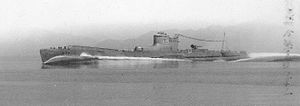| Japanese submarine I-15 (1939) | |
|---|---|
 Japanese B1-type I-15 submarine at initial sea trials | |
| Career (Japan) | |
| Name: | I-15 |
| Laid down: | January 1938 |
| Launched: | March 7, 1939 |
| Commissioned: | September 30, 1940 |
| In service: | 1940-42 |
| Struck: | December 24, 1942 |
| Fate: | Sunk, November 10, 1942 |
| General characteristics | |
| Class & type: | Type B1 submarine |
| Displacement: |
2,584 tons surfaced 3,654 tons submerged |
| Length: | 356.5 ft (108.7 m) |
| Beam: | 30.5 ft (9.3 m) |
| Draft: | 16.8 ft (5.1 m) |
| Propulsion: |
2 diesels: 12,400 hp (9,200 kW) Electric motors: 2,000 hp (1,500 kW) |
| Speed: |
23.5 knots (43.5 km/h) surfaced 8 knots (15 km/h) submerged |
| Range: | 14,000 nautical miles (26,000 km) at 16 knots (30 km/h) |
| Test depth: | 100 m (330 ft) |
| Complement: | 94 |
| Armament: |
6 × 533 mm (21 in) forward torpedo tubes 17 torpedoes 1 × 14 cm/40 11th Year Type naval gun[1] |
| Aircraft carried: | 1 Yokosuka E14Y seaplane |
I-15 was a Japanese B1 type submarine. She was completed at Kure Navy Yard on September 30, 1940, whereupon she entered into service with the Imperial Japanese Navy. Her first and only commanding officer was Commander Nobuo Ishikawa. I-15 operated off the north coast of Oahu during the raid on Pearl Harbor. Her second wartime patrol, in May and June 1942, took her to the Aleutians, where she conducted reconnaissance of several islands. I-15's third and final patrol took place from August to November 1942, when she operated in the Solomon Islands in the South Pacific, supporting the Japanese efforts to hold Guadalcanal. One source (Morison) suggests that I-15 hit the battleship USS North Carolina with a torpedo on September 15, 1942, but more recent authorities (Hackett & Kingsepp) maintain that the torpedo came from another submarine operating in the area, I-19. On November 10, 1942, a U.S. ex-destroyer (modified to a fast minesweeper), USS Southard (DMS-10) sank I-15 in Cape Rechereche, San Cristobal, with all hands lost.[2] Commander Ishikawa was promoted to the rank of Captain posthumously. On December 14, 1942, more than one month after I-15 sunk, the USS Wahoo (SS-238) sank an unknown submarine which it misidentified as the I-15.[3]
Sources[]
- Hackett, Bob & Kingsepp, Sander. HIJMS Submarine I-15: Tabular Record of Movement. http://www.combinedfleet.com/I-15.htm. Retrieved on March 15, 2009.
- O'Kane, Richard H. (1987). "Wahoo: The Patrols of America's Most Famous WWII Submarine". Presidio Press. ISBN 978-0-89141-301-1.. Rear Admiral USN (ret.) O'Kane was Wahoo's executive officer on her first five war patrols.
- Morison, Samuel Eliot. The Struggle for Guadalcanal, pp. 131–34, 233. Volume 5 of The History of United States Naval Operations in World War II (1949). Edison, NJ: Castle Books, 2001.
Notes[]
- ↑ Campbell, John Naval Weapons of World War Two ISBN 0-87021-459-4 p.191
- ↑ "Imperial submarines I-15". Combinedfleet.com. http://www.combinedfleet.com/I-15.htm. Retrieved 16 December 2012.
- ↑ O'Kane 1987, p. [page needed].
| ||||||||||||||
The original article can be found at Japanese submarine I-15 (1939) and the edit history here.